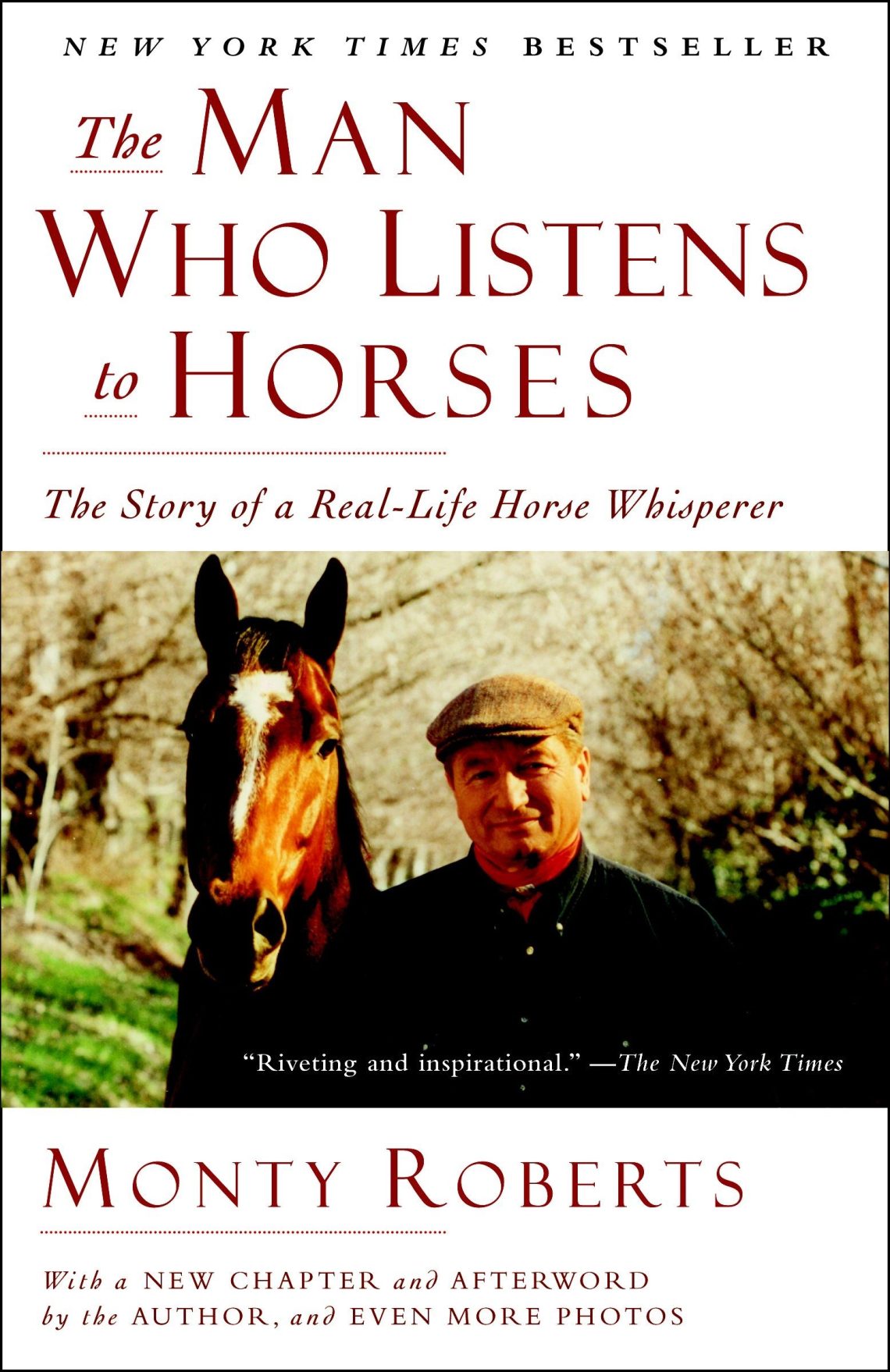
The Bucking Horse (chapter from Monty Roberts’ Hand to Hand: Lessons I’ve Learned from My Life of Training Champion Horses)
Contents
bucking horse
Chapter from Monty Roberts’ Hand to Hand: Lessons I’ve Learned from My Life in Training Champion Horses
In this section, I want to talk about the horse’s habit of kicking, not just about horses that may kick several times during a ride. I propose to investigate the reasons why horses kick, and I also want to tell you how to rid them of this problem and prevent it from happening again. Many people come to me with their horses that have developed a kicking habit. I include such skittish horses in my demonstrations, firstly because of the danger of this habit, and secondly, because of the large number of horses with this problem. When it comes to horses whose behavior needs to be corrected, I am convinced, based on experience around the world, that bucking, along with the difficulties of farrier work, keeps second place in line with the problems and difficulties of loading horses into a horse carrier.
The fact that I have included this problem in need of correction in this book does not at all mean that I suggest that you use these techniques personally, unless, of course, you are young, strong and have perfect riding skills. It is important to learn these concepts and understand the value of using them without violence. You will have to study everything on your own before seeking help from a qualified professional. If you decide to help your horse overcome the urge to kick, you need to do an in-depth study of the qualifications of the professional you have chosen, without recklessly putting your horse in the hands of the first specialist you meet.
Anyone working with bucking should first check the horse’s back to make sure the animal is not in pain in that area. If there is a problem with an ill-fitting saddle, then there is likely to be a reaction on the part of the horse, one way or another aimed at survival. If your horse reacts by kicking the saddle or rider more than two or three times, consult by a veterinarian or qualified physician. Obviously, if there is a medical problem, it must be corrected before proceeding.
When nothing hurts the horse, I recommend checking the condition of the saddle, saddle pad, girth to make sure that there are no elements in them that can cause pain to the animal. When all potential sources of pain are removed and the proper harness is in place, it can be assumed that your horse has a psychological problem with saddle and rider rejection.
Remember that all the actions of the horse are subject to its desire to survive. So we can reasonably assume that the horse is thinking, “There’s something on my back that wants to kill me. I need to get rid of it.”
At this stage, you need to understand that the horse in his natural environment wants to enjoy a peaceful existence. She does not want to kick, because for her it is hard work. Most rodeo horse suppliers agree that one of the hardest jobs is getting a horse to buck all the time. A very small percentage of bucking horses continue to perform adequately after a long period of time. This is the reason why consistently bucking and efficient horses cost tens of thousands of dollars.
Kicking is often a manifestation of suppressed energy. There is no need to punish the horse for being in a cheerful mood. When I ride horses in barrels, about 65% of them kick after trying on the saddle for the first time. This is a natural reaction to what they perceive as a predator suddenly attacking their back. If I send them out to run around the barrel and let them think through the problem, they, with a few exceptions, calm down and join me. Obviously, the horses prefer to return to me, to their new safety zone, instead of being isolated and running. Very few horses driven using my method buck at all with the first rider, and perhaps less 5% of these horses are kids and try to kick. To prevent such a reaction from becoming a habit, it is necessary to use the skill of riding.
A bucking horse can be (and usually is) very dangerous. It is worth noting that thousands of people were left disabled due to injuries inflicted on them by kicking horses. But we must not forget that tens of thousands of horses were deprived of their lives due to the fact that kicking became their habit, and they could not be ridden.
Buck stopper
With these facts in mind, and with an overwhelming desire to save horses and prevent injury, I developed a number of special techniques. I advise you to use a device that prevents kicking, which I called the buck stopper. I have been using this tool for over 50 years and can safely say that I have never hurt a horse using it. Avid thugs treated using this device sometimes developed a pink line on their upper gums within two or three days, but it soon disappeared without any consequences.
The adaptation is inert until the horse begins to kick and allows the animal to discipline itself. If a horse moves with its head in a natural position, it will react to the rider as if the device didn’t exist at all. It will not affect the horse in any way until he tries to lower his head down to the ground. An effective bucking horse usually performs these actions with its head straight between its front legs. Often, an effective kicker will jump forward, high into the air, keeping its head in a natural position, aiming to lower its head close to the ground as its front legs touch the ground. During this process the rider tries to sit upright while the horse bounces high, but then he yanks the reins towards the head or top of the horse’s neck. It is in this way that the rider often injures the face, neck and head. He is also often thrown forward onto the ground in front of the horse. The horse’s next jump can be very dangerous for the rider on the ground in front of it.
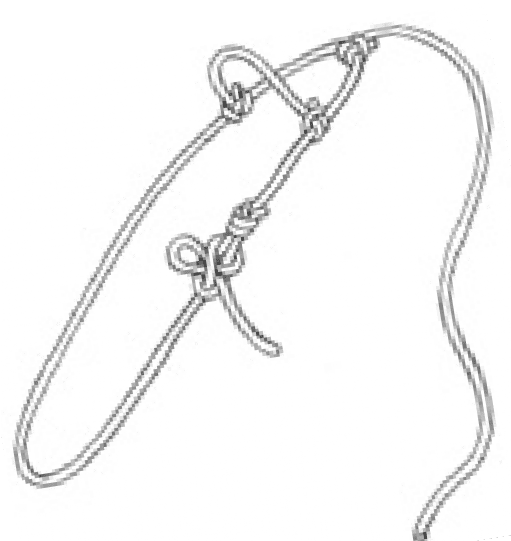
The buck stopper is a simple and effective tool.
If a bucking horse jumps on a rider who has fallen from it, this can lead to serious injury and even death for him. The whole reason is the beating hooves of the horse, descending with enormous pressure per square centimeter. Given the catastrophic consequences of kicking for both man and horse, the use of a buckstopper is undeniably necessary and appropriate.
How a kicking horse is raised
Whenever I deal with a problem that needs to be corrected, I find it interesting and informative to think about what I would do if I set out to teach a horse to do something that I think needs to be corrected.
If a horse exhibits a certain behavioral pattern and feels that it has gained something in doing so, then it will obviously repeat that behavior. If a horse starts using a certain pattern but then finds it unproductive, he will most likely stop using it. Let’s explore one common fictional scenario that creates a kicking habit that needs to be corrected later.
Suppose we have a young horse that has been ridden for several months. She cooperates well with the rider and learns the lessons well. The rider is very busy or for some reason cannot ride the horse for several days, allowing the horse’s energy level to be significantbut rise. Without paying due attention to this, our rider, as usual, saddles his horse and mounts, expecting a pleasant ride. But the young horse explodes. She kicks as she might kick if she were let out in the field to play. Our rider, however, is caught unawares and thrown off – he has suffered, if not physically, then at least from hurt pride. “She has never done this before,” the rider says. She has always been a golden horse. Probably, so that she no longer kicks, she needs to be taught a serious lesson.
The horse kicks and in the process of kicking throws off the rider. In the language of Equus, this means receiving a reward. The reward gives an incentive to repeat the experience, which means the horse is able to do it again. If it is roughed up, it is likely that the horse will download into his brain that when he kicks, he will either be rewarded or beaten. She will strive to kick even harder. After four or five sessions of such behavior, our rider will have at his disposal a “strider”, whose behavior needs to be corrected.
Many books have been written about what kind of whip and how to whip a bucking horse. I remember reading books that paid tribute to young riders whipping the horse at every jump. In one book, I remember, it was about the need to whip horses between the ears so that the tip of the whip hit them on the nose. It was said that this would stun the horse, make it obey, as a result of which the animal would stop kicking. In the book by R.S. Summerhayes “Problem Horse” (Summerhays RS The ProblemHorse. – SRSmith, 1940) the author states: “Personally, when a horse kicks, I immediately, as it should, hit him a couple of times on the shoulder …”.
Undoubtedly, the most skillful “kickers” appear where a whip is used to work with a kick. I have worked in many such places, where most of the horses, who can kick very skillfully, take part in various sports. Such horses kick until they are 14 years old. Pretty common thing hear: “Careful with him, he is slightly greeted.” This means that he will most likely throw you off. I have seen 12-year-old horses work 4-5 hours and then double over and throw you off with ease, for no apparent reason.
The goal of every rider should be to lower the adrenaline during bad behavior, and the whip will do the exact opposite – only help increase it. A trainer who believes in the effectiveness of whipping a horse while kicking fails to understand that in the animal’s brain, this simply increases his fear and does nothing to help him find a sensible reason to stop.
A horse that has gained a reputation for bucking is more likely to cause anxiety and nervousness in its rider. And an insecure rider, in turn, exacerbates the problem, leading to the fact that the horse will kick for sure. These horses are often sent up for auction and end up in the hands of unsuspecting owners. More often than not, they continue to be treated even more harshly, which only reinforces their bad reputation. In the end, the only buyer at the auction is the guy with the truck, who goes straight to the slaughterhouse.
Having described all the circumstances, it is important to note that a kicking horse that has been punished is unpredictable. She looks more like a street fighter than a professional champion. This usually makes her more dangerous than the predictable, professionally kicking animal. A horse that has been punished kicks with anger and is more likely to injure its rider than a horse that has been trained to kick without using pain as a learning tool.
Now, in an attempt to better understand the kicking horse whose behavior needs to be corrected, let’s examine how horses are taught to kick and maintain that behavior over an extended period of time.
Whatever have you done to train a good bucking horse for rodeo competition? Intrigued by this issue, I spoke to several of the best buck horse suppliers in North America. What follows is a collection of their thoughts on the most appropriate methods of rearing kicking horses.
How to train a horse kick
It is recommended to start by choosing a healthy, strong horse with an athletic build. Some successful brutes are a mix of thoroughbreds and draft horses, giving them size, strength, and athleticism. Moreover, if horses want to kick, then it doesn’t matter if they are grown at home or in nature.
If you have a horse with good potential, place it in a buck pen and saddle it with a special rodeo saddle officially approved by the Association of Rodeo Professionals. Fasten the saddle tightly, but leave the release mechanism on both front and back girths. Keep the horse calm and allow the animal to review the situation without any hostile behavior on your part. Open the gate and let the horse voluntarily leave the pen. Don’t apply pressure or hurt the horse, because you want the experience to be enjoyable for the horse.
If your charge is prone to kicking, he will jump high and kick, trying to throw off his saddle. Allow this behavior, but no more than two jumps, and then pull the release rope and let the horse drop the saddle. Then let the horse settle down in the arena and enter the trap pen, passing through the stripping chute. Repeat this process once a day for three to four days in a row, gradually increasing the amount of time until you unfasten the saddle and allow the horse to drop it. In that reward for her. Experts recommend no more than five jumps in each of these procedures.
If your ward is talented, he will bounce higher and more aggressively try to get rid of the saddle. At this stage, give him a few days off and then repeat the process. It is best to make sure that the horse is healthy and that nothing is hurting him, as this will weaken his desire to kick properly.
After four or five sessions with a three to four day break in between, the rider can be brought in. It is good that this is a rider who knows these procedures, young and athletic. The rider must be able to jump out of the saddle at the moment when the horse kicks with all its might. Instruct the rider to stay with the horse for no longer than four or five jumps and then dismount as safely as possible. The side fastener should be released as soon as possible after the rider has jumped off. When a horse kicks without a rider, help him quickly find the stripping chute. Each time a horse passes through the arena, it must pass through the stripping chute to enter the paddock. Remove the ammunition from the horse as quickly as possible.
As before, take a break of four to six days between exercises of at least five to six controlled sessions before any rider tries to stay on the horse for the full eight seconds. This is the time when you need to assess your horse’s potential to be a rodeo horse. It is likely that by then the horse may be willing to stop kicking. If this is the case, then train it like a saddle horse, using the exercises recommended to prevent horses from kicking, instead of continuing to train the horse to kick.
If the horse shows promise and bucks with great enthusiasm at the end of guided training sessions, look for riders who are learning the art of riding a bucking horse. Usually they have not yet learned to stay in the saddle for a long time, allowing the horse to win in its attempts to get rid of everything that is on its back. Some of the best animal suppliers turn to rodeo schools, and the horse is left to buck there for six months to a year before professional riders feel the power of his talents.
During this training period, the animal must be well fed, hooves cared for and a few days between sessions. Horses need to be given moderate exercise in a fairly spacious area. It is recommended to use a rider and a saddle horse to encourage him to gallop about a mile a day.
If, using the techniques described earlier, we can train a horse to kick predictably, then by using the opposite techniques, we can prevent the desire to kick and get rid of the habit of doing so! The most obvious thing that spurs on a professional bucking horse is the reward it receives by throwing off its equipment or rider. It turns out that a knowledgeable trainer is obliged to create an environment in which it will be difficult for the horse to receive this award. It just so happens that it’s much safer to train a horse without being exposed to the danger of being thrown off it.
Correction of a bucking horse
Let’s now return to a world where kicking is considered a disadvantage. While it is interesting for us to explore the formation of the bucking horse, this is an area in which few of my readers are involved. Now that we know how to teach a horse to kick like a pro, let’s look at the procedures that are required to wean a horse from this dangerous habit.
I firmly believe that when you are dealing with a problem that needs to be corrected, you need to create an environment for yourself in which you can smile.
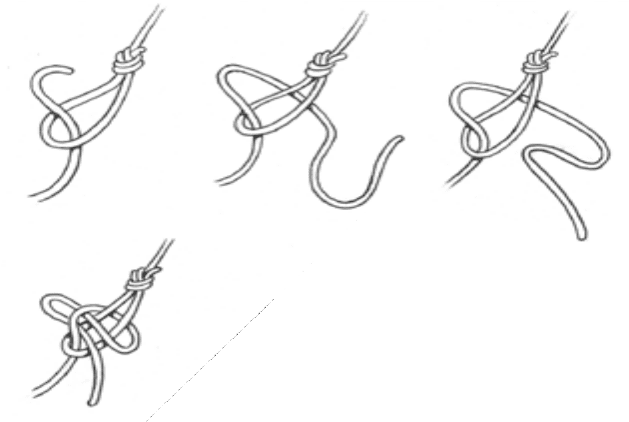
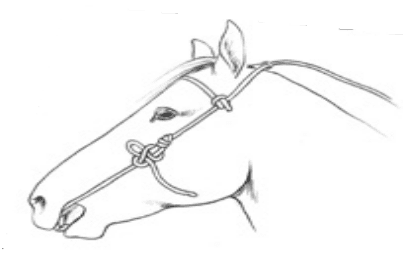
The knot used to tie the buck stopper, along with a picture of how it should fit on the horse’s head.
When a horse is acting out behavior that needs to be corrected and you are unable to remain calm and comfortable, then you have not created the right environment. Safety is of paramount importance. You will need the right equipment and the right environment to work with a horse that needs to be trained to kick. I believe that the best place to train with such a horse is a reliable barrel. I advise you to have a barrel about 16 meters in diameter, with blank walls at least two meters high. It is important to have a safe, non-slippery ground with at least 3,5 cm of padding on the base. You will need a double halter, saddle with a girth, underbelly, an English saddle with a girth, or a good Western saddle if the rider prefers it. You’ll also need a life-sized stuffed animal or mannequin and many hours of experience putting all that gear on a horse. A buck stopper is another essential piece of equipment on this list, as is a good snaffle or hackamore for to lead the horse, and, of course, a leather belt for fixing the stirrups.
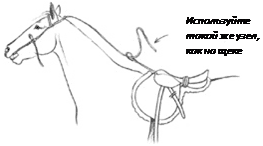

This is how the buck stopper is attached to the English saddle:
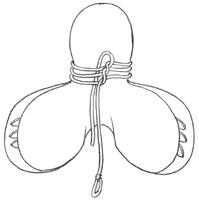
We equip the English saddle with a device that prevents kicking
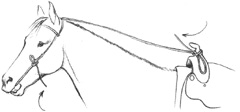 (Pull to quickly untie)
(Pull to quickly untie)
Western saddle attachment:



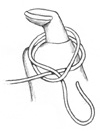
How to knit a tie knot to attach a buck stopper to a western saddle
 Pull to quickly untie
Pull to quickly untie
As in almost every situation, I suggest starting with the Join-Up method. If necessary, set aside several days of 30-40 minute sessions so that all four goals—connecting, following, touching vulnerable areas, and lifting your legs—are achieved with ease and comfort. Having achieved this, and assuming that you are well trained and competent in the use of the listed equipment, you can continue to work with your bucking horse, whose behavior needs to be corrected. Do not continue this training program if you have any doubts about your level of competence. Get your charge into the barrel and join-up again, achieving all four goals above – joining, following, touching vulnerable areas, and lifting legs. Then bring it to the center of the barrel and put the buck stopper on it. Lay the saddle on the horse’s back and tie the rope to the buck stopper. Be safe by buckling the girth of the saddle and then allow the trainee to kick in the barrel if he wants to. Let him gallop freely until attempts to kick stop. At this stage, the horse should be well polonged in the recommended way (ch. 6), using the side reins on the saddle as a guide for the reins. With a buck stopper, you can train your horse to be quite adept at lunging. The buck stopper will not interfere with this process.
Often the sensation of the reins around the sides and hind legs of the horse will cause kicking, and this will be another possibility.ness for the horse to learn.
Following safe procedures, use the Join-Up method again, remove the saddle, placing a small English saddle on the horse. Strap on the buck stopper and have your trainee gallop in both directions of the barrel with both the saddle and the anti-buck device.
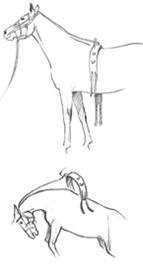
Tie the buck stopper to the saddle until the horse begins to kick. Then, if the horse kicks, everything will untie.
If after a few laps the horse doesn’t stop kicking in both directions, try again with the English saddle on another day. However, if the horses are comfortable and the buck stopper is working effectively, most horses stop bucking in less than a minute.
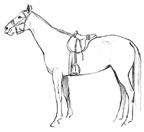
Position the saddle over the saddle, then remove the saddle.
If your ward has calmed down and rides with an English saddle, untie the stirrups so that they dangle at the sides (see chapter 4). Then I recommend lunging the horse again to train him to respond to the snaffle while still allowing the stirrups to be active and visible on the sides. With the stirrups fixed to the sides of the horse and the girth properly tightened, you can move on to using your rider dummy. Fix the dummy to the English saddle following safe procedures. This usually provokes aggressive kicking from the horse, whose behavior needs to be corrected. Don’t take this as a bad thing, as the horse is under the influence of the buck stopper, which discourages kicking. If you find it difficult to get the mannequin on the horse, you can try using a rolled up blanket first. Tie it with small ropes in three places so that it is attached to the saddle and to each stirrup. Work with this blanket until your horse is comfortable with tying and untying it. This will serve as an effective preparing to use the mannequin.
I recommend going the safe route and using the dummy for a few days before you start working with a real rider. To get the horse accustomed to the presence of the dummy, move it as if it were jumping up and down next to the horse before laying it belly on top of it. Again, longing can be very helpful during this process. It is important to note that you should never lunge with a rider on horseback, but lunging with a dummy can increase the horse’s confidence and willingness to accept guidance from the rider. on horseback.
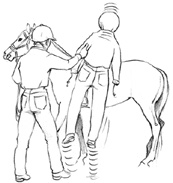
The dummy is used to simulate jumping up and down so that the horse gets used to its presence.
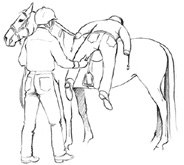
Let the horse feel the weight of the dummy by laying it on the animal’s belly.
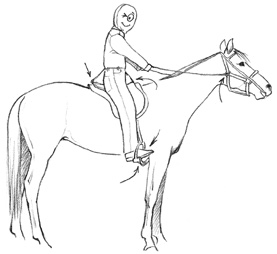
Stirrups must be tied under the horse with a belt.
How to fix the mannequin on a horse: (1) with a rope to the pommel of the saddle; (2) with a rope to the pommel of the saddle; (3) tie hands to the rein; (4) tie shoes to stirrups.
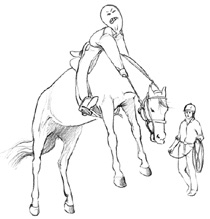
Let the horse work with the dummy before using the rider.
Lunging with a dummy can make you want to kick more and therefore require more practice, as the buck stopper is only effective when kicking. You can use the double halter (chap. 7) while lunging by attaching a rein to each of the training rings. This will affect the horse in much the same way as side reins, which is usually quite effective. At this point, if you like, you can use a snaffle bridle. When your rider is completely comfortable with the mannequin and is galloping daily without trying to kick, only then can you move on to working with a real rider. If the rider prefers using a western saddle, take an extra day or two to get the horse used to the saddle and dummy so there are no surprises when the rider mounts. If you choose to use a double girth western saddle, use the side girth with the dummy for a few sessions before moving on to the actualriding rider.
When a rider mounts, it is best to immediately help him sit in the saddle and not first lay him on his stomach on the horse. Don’t forget that the mannequin has been mounted on a horse many times and has been placed on the horse in different places, making it look like it is jumping up and down on the ground. Unfasten the cord from the bridle head while the rider is seated. This will reduce the chance of him getting tangled in the lunge if the horse starts to act before you have a chance to unfasten the lunge.
Make sure the buck stopper is in place during each of these training sessions as it is very important that the horse learns early and then well that every time he kicks he is punishing himself. resting on a device that prevents kicking.
I’m sure the buckstopper should be used for at least two or three weeks for most thugs. Then it should be replaced with an imitation fixture.
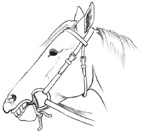
Imitation buckstopper.
I advise competent riders to ride a horse that needs to be weaned from kicking for 30 days or so alongside a well-trained horse that the kicking horse knows, if possible. If your ward decides to throw a tantrum, the calm influence of a trained horse will be very valuable, in fact, as well as the presence of another person in case of an unforeseen situation.
Using the buckstopper, I have helped hundreds of horses change their behavior patterns and wean them off the habit of kicking in a short amount of time. However, even when working with it, you must be careful. Always show respect for the horse you are training to kick, and be vigilant not to overlook potentially dangerous situations. Be prudent and extremely careful at every stage of dealing with this problem.
Monty’s findings
- Eliminate physical pain.
- Do not use ammunition that causes pain.
- Amateurs and inexperienced riders should not attempt to work with a bucking horse.
- Use a secure environment.
- Make sure your ammo is in perfect condition.
- Practice on safe and suitable ground.
- Your work area must be fenced off.
- Never hit a bucking horse.
- It’s always better to play it safe.
- For your safety, do not skip any of the steps in the above procedures.
The material is published with the consent of the copyright holder.
You can purchase the author’s book “From Hand to Hand: Lessons I’ve Learned from My Entire Life of Training Champion Horses” at the Horse Shop Prokoni shop.





